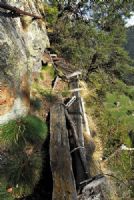 |
 |
The history of the Ru

Ru Courtod was entirely the work of approximately one hundred families living on the hillside of St. Vincent and within the communes of Emarèse and Challant-Saint-Anselme who, driven by the need to irrigate vast areas of very arid farming land, conceived and built an immense channel able to carry water 25km from the foot of Ventina Glacier at 2,150m altitude to the saddle of Col de Joux at 1,650m.
The idea of the Ru arose from the lower classes, which was rather unusual for those times, and a formal request was made to the local lord, Count Ibleto of Challand, through whose lands the channel was to be dug. With an act of enfeoffment, he authorised the works to begin on payment of the fee of 80 florins, a yearly payment of two florins of “good gold” and the right to irrigate his lands every Tuesday, day and night.
Armed with great tenacity, practical skill, common sense and iron rules of conduct (channel working hours and methods, election of work management board and administrators divided by village, choice of trustworthy contractor, supplying of work tools: pick-axes, spades, crowbars, wedges, sledgehammers and hoes), the peasants continued their work regularly during fine weather for forty years until 1433, the year of ratification by Count Francois of Challant.
It is important to note that many stretches of the channel wind their way through sheer rock walls, so true miracles of engineering construction work had to be carried out to continue.
The Ru worked perfectly for almost two centuries, bringing wealth to the farmers of those times, until 1630 when the plague spread through Valle d’Aosta, diminishing a large part of the population of Emarèse and Challant- Saint-Anselme. As there was insufficient labour for its upkeep the stretch of channel supplying these villages was abandoned and the surviving few inhabitants lost their rights to the water until the second half of the last century when this ruined stretch was re-opened after vast works diverted the water into pipes.
Today the Ru plays the important role of witness to a true “epic of peasant work”.








